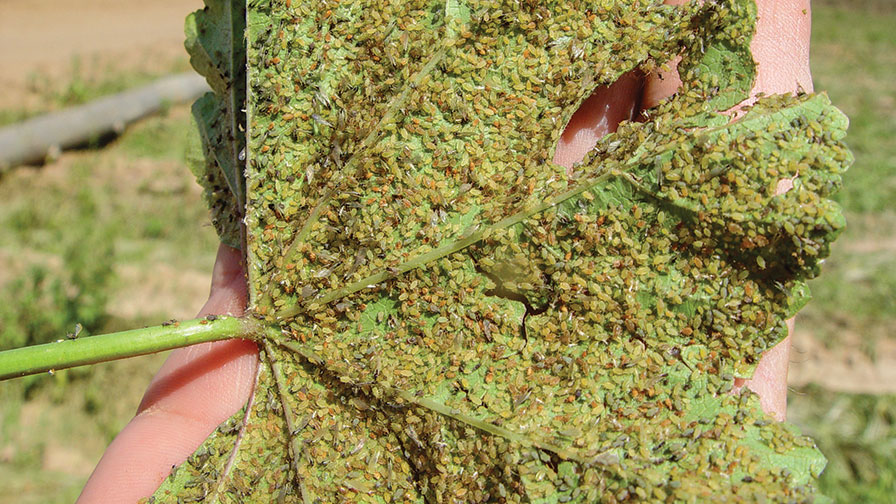Weeds Shelter Vegetable Insect Pests

Green peach aphid infesting cheeseweed found adjacent to a lettuce field. Photo by John Palumbo.
Leafy vegetable and melon production in the desert Southwest requires effective weed management for all the obvious reasons. It’s also essential for another important, but often overlooked, reason.
Several common weed species can serve as host plants for many important insect pests. And when weeds are not controlled in the field, they can be an impediment to insect control.
Weeds can serve a beneficial role by harboring insects’ natural enemies and pollinators. But the resulting consequences often outweigh the benefits they potentially provide.
Refuges for Beneficial Insects
Flowering weed species can provide a source of nectar and pollen for a number of important insects such as honey bees and native pollinators important for cucurbit and seed production. There are also numerous examples of how weeds can serve as a refuge for beneficial insects.
Parasitic wasps and predatory insect species can build up to large numbers in weedy areas. They subsequently migrate into adjacent vegetable fields, where they can feed on damaging insect pests.
Of course, these same weedy refuges can serve as host sources for many key insect pests. Those will likely later cause economic damage to vegetable crops.
Reservoirs for Insect Pests
Many of the key insect pests that infest leafy vegetables and melons are polyphagous, capable of feeding and reproducing on a multitude of crops and weeds in several plant families.
Weeds in field margins and ditch banks can provide insect pests with suitable resources needed for rapid population growth. These pests can subsequently move onto adjacent crops.
Green peach aphids, for example, can build up to high numbers on cheeseweed and London rocket during the winter. They then invade nearby leafy vegetable crops in the spring.
Many weed species act as bridges between cropping seasons when vegetable crops are not in production. Although many insects can move relatively long distances to find new food sources, unchecked weeds in fallow fields fosters a key source of insect infestations. We annually observe pale-striped flea beetle and beet armyworm inhabiting common purslane in fallow fields prior to fall vegetable and melon plantings.
Another host source for insect pests of vegetables are volunteer crop plants that are considered weeds (a plant out of place) when allowed to grow in fallow fields or within crops.
In the desert Southwest, for example, volunteer melons from previous spring crops can be found in fallow fields that will eventually be planted with fall vegetable crops.
If not controlled in a timely manner, these weedy volunteers can sustain large numbers of migrating insect pests, as well as plant viruses that are transmitted by insect vectors.
Reservoirs for Insect-Transmitted Viruses
Weeds are notorious for harboring important plant viruses and their insect vectors that damage leafy vegetables and melons.
One of the primary insect vectors of an important tospovirus, tomato spotted wilt virus, is the Western flower thrips. Not surprising, two common weed species, lambsquarters and cheeseweed, readily found in the Western U.S., serve as hosts to both the vector and the virus.
Similarly, these weed species serve as a host for a number of aphid-transmitted potyviruses such as watermelon mosaic virus and zucchini yellow mosaic virus found in melons.
Sweetpotato whitefly transmits another important plant virus, cucurbit yellow stunting disorder virus. It’s a major problem for desert melon production. Initially, the industry thought only cucurbits hosted the virus. But recent research shows several common weeds serve as reservoir hosts, including redroot pigweed, Wright’s groundcherry, and silverleaf nightshade.
Impediments to Insect Control
If growers weeds don’t properly control weeds during stand establishment, weeds can interfere with insect control on seedling plants. Dense weed foliage can shield plants, intercepting insecticide spray droplets before reaching the crop. This can result in unacceptable plant damage from insect feeding on the untreated foliage. Some weed species such as Wright’s groundcherry or volunteer cantaloupes all too effectively shield seedling plants from sprays.
Growers in the desert Southwest treat most vegetable and melon crops with soil-systemic insecticides (i.e., imidacloprid, cyantraniliprole) for early season control of whiteflies, aphids, and beet armyworms. They apply these insecticides in-furrow or beneath the seedline during planting operations. That makes the insecticide active systemically in plants via root uptake during germination and seedling growth.
Weeds growing unchecked during stand establishment compete with the crop for water and fertilizer as well as for soil insecticides. Excessive weed densities can significantly intercept soil insecticides and reduce the amount necessary for effective insect management.










